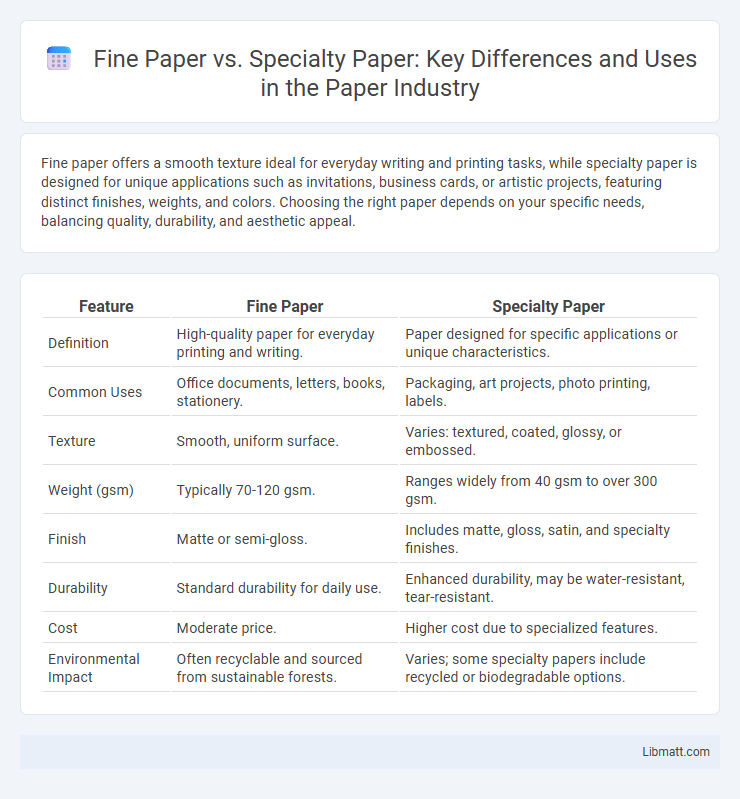Fine paper offers a smooth texture ideal for everyday writing and printing tasks, while specialty paper is designed for unique applications such as invitations, business cards, or artistic projects, featuring distinct finishes, weights, and colors. Choosing the right paper depends on your specific needs, balancing quality, durability, and aesthetic appeal.
Table of Comparison
| Feature | Fine Paper | Specialty Paper |
|---|---|---|
| Definition | High-quality paper for everyday printing and writing. | Paper designed for specific applications or unique characteristics. |
| Common Uses | Office documents, letters, books, stationery. | Packaging, art projects, photo printing, labels. |
| Texture | Smooth, uniform surface. | Varies: textured, coated, glossy, or embossed. |
| Weight (gsm) | Typically 70-120 gsm. | Ranges widely from 40 gsm to over 300 gsm. |
| Finish | Matte or semi-gloss. | Includes matte, gloss, satin, and specialty finishes. |
| Durability | Standard durability for daily use. | Enhanced durability, may be water-resistant, tear-resistant. |
| Cost | Moderate price. | Higher cost due to specialized features. |
| Environmental Impact | Often recyclable and sourced from sustainable forests. | Varies; some specialty papers include recycled or biodegradable options. |
Introduction to Fine Paper and Specialty Paper
Fine paper, typically used for everyday printing and writing, features smooth texture, high brightness, and consistent quality, making it ideal for office documents and commercial printing. Specialty paper encompasses a diverse range of papers designed for unique applications, including coated, textured, or colored varieties used in packaging, invitations, and artistic projects. Both fine and specialty paper serve distinct purposes based on their material composition, surface finish, and intended end-use.
Defining Fine Paper: Features and Uses
Fine paper is characterized by its high-quality fibers, smooth texture, and bright whiteness, making it ideal for everyday printing, writing, and office use. Specialty paper, in contrast, includes a wide range of unique textures, weights, and finishes tailored for specific purposes such as packaging, invitations, or artistic projects. Your choice between fine paper and specialty paper depends on the desired appearance, durability, and function of the printed material.
Understanding Specialty Paper: Key Characteristics
Specialty paper distinguishes itself from fine paper through unique features like enhanced durability, specific textures, and specialized coatings designed for particular applications such as packaging, labels, or art prints. These papers often exhibit higher opacity, moisture resistance, and abrasion resistance, tailored to meet industry-specific demands. Understanding these key characteristics is essential for selecting the appropriate paper type in commercial printing, product design, or creative projects.
Differences in Manufacturing Processes
Fine paper is produced using chemical pulp with a focus on brightness, smoothness, and uniformity, involving processes like bleaching and refining to achieve high-quality print surfaces. Specialty paper manufacturing incorporates unique raw materials, additives, or treatments such as embossing, coating, or impregnation to impart specific properties like durability, texture, or resistance. The fundamental difference lies in fine paper's standardized production for general use versus specialty paper's customized processes tailored to niche applications.
Applications of Fine Paper
Fine paper is widely used for everyday printing, publishing, and office tasks due to its smooth texture, high brightness, and excellent printability, making it ideal for books, magazines, brochures, and stationery. It supports high-quality image reproduction and text clarity in corporate reports, marketing materials, and educational publications. This versatility and consistent performance make fine paper a preferred choice for commercial printing and professional communication needs.
Applications of Specialty Paper
Specialty paper finds extensive use in packaging, labels, and industrial applications requiring unique properties such as water resistance, high strength, or chemical resistance. It is also crucial in healthcare for disposable medical supplies and in security for currency and certificates. These applications demand precise functional characteristics that fine paper lacks, making specialty paper indispensable in niche markets.
Cost Comparison: Fine Paper vs. Specialty Paper
Fine paper generally offers a lower cost per sheet compared to specialty paper, making it a budget-friendly option for everyday printing and office needs. Specialty paper, designed for specific uses like high-quality presentations or artistic projects, costs more due to its unique textures, weights, and finishes. Your choice between fine and specialty paper should balance cost-efficiency with the specific look and feel required for your project.
Print Quality and Performance
Fine paper delivers consistent print quality with smooth texture, making it ideal for everyday documents and professional printing tasks. Specialty paper offers enhanced print performance through unique coatings or textures that improve color vibrancy, durability, and tactile appeal for specific applications such as invitations or marketing materials. Your choice between fine and specialty paper impacts the clarity, sharpness, and overall impression of your printed content.
Environmental Impact and Sustainability
Fine paper generally has a lower environmental impact due to its production from recycled fibers and sustainable forestry practices, making it a more eco-friendly option. Specialty paper often requires unique fibers, coatings, or treatments that can increase energy consumption and chemical use, leading to a higher environmental footprint. Choosing fine paper certified by organizations like FSC or PEFC supports sustainability and reduces deforestation compared to many specialty paper variants.
Choosing the Right Paper for Your Project
Fine paper offers smooth texture and consistent quality ideal for everyday printing, writing, and professional documents, ensuring crisp text and vibrant images. Specialty paper, designed for unique uses like invitations, packaging, or artistic projects, provides distinct finishes, weights, and textures to enhance your design's visual and tactile appeal. Choosing the right paper involves assessing your project's purpose, required durability, and desired aesthetic to achieve optimal presentation and functionality.
Fine paper vs specialty paper Infographic

 libmatt.com
libmatt.com